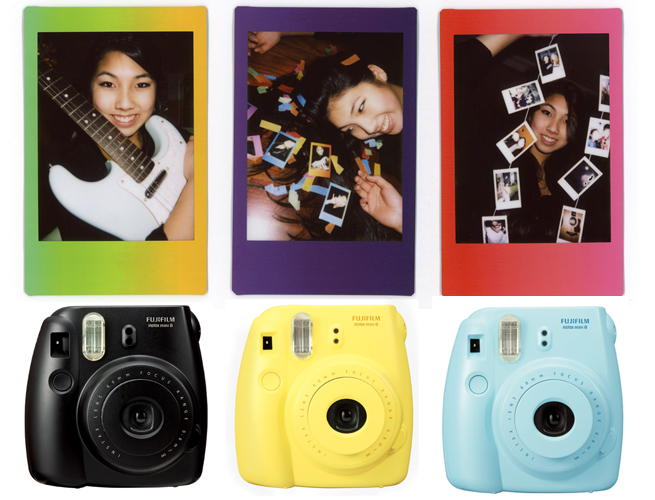
Goldy Bardin is a creative director at Organic, Inc.
CES 2013 was full of innovators—all the big names in technology you would expect, plus a host of surprising startups. Their bright minds and smart designs didn’t disappoint, for the most part.
But as I walked the floors, two brands stood out to me: Fujifilm and Polaroid. Both are once-great analog brands that have have had to make the leap to digital. Over the years, both have expanded their core product lines with various consumer electronics, but both brands have declined substantially since their glory days.
So I took a closer look to see how these tried and true brands are keeping pace with the amazing innovation that’s happening in 2013.
Polaroid
I started with Polaroid. As a marketer, I was curious about how they were differentiating themselves from innovative brands like Sony and LG. As I explored their booth, I was intrigued by the archival displays from their past. They truly are a nostalgia brand. I still remember my first Polaroid camera and how fun it was to instantly see the photo I had taken. Edwin Land, Polaroid’s founder and inventor of the instant camera, really understood the value of instant gratification.
 At first I was impressed by their new iM1836 Interchangeable Lens connected camera with Android 4.1 “Jelly Bean.” A great idea. But as soon as I picked up the camera it felt, well, cheap. It took a while to start up and getting from screen to screen was glitchy and slow. There was no “instant” anything. And it wasn’t gratifying.
At first I was impressed by their new iM1836 Interchangeable Lens connected camera with Android 4.1 “Jelly Bean.” A great idea. But as soon as I picked up the camera it felt, well, cheap. It took a while to start up and getting from screen to screen was glitchy and slow. There was no “instant” anything. And it wasn’t gratifying.
Granted, this was a display model that had been handled by thousands of attendees, but it was a far cry from the Samsung Galaxy Android-enabled camera, which was pleasing to the eye, incredibly fast, and also featured great apps like Best Face. That said, why would I pay for an extra data plan for any connected camera when I could just deck out my phone with the sleek i.am.plus foto.socho?
I also checked out another new device—the Polaroid Kids Tablet. I used to market Leapfrog products, which are really kid-friendly and intuitive, so I was excited to check it out. The design was cute, but definitely skewed toward younger pre-school aged children. It runs on Android Ice Cream Sandwich, so the interface is somewhat intuitive, with icons that kids who can’t read yet can most likely interpret. However, the navigation buttons were small and butted up next to the beveled chassis, so they were hard to reach, even for smaller fingers. The main features seemed to be indestructability and parental controls. A pretty good idea, but the overall design was a disappointment.
Polaroid has been making quite a few announcements lately, including a new retail strategy that includes Fotobar storefronts where you can print your digital photos. However, as a Creative Director, and someone with affinity for their brand, I wish they would innovate products and develop a marketing strategy that embraced the notion of instant gratification. The iM1836 camera and Kids Tablet seemed like attempts to fill perceived gaps in the market, but didn’t really deliver on the strength of the brand heritage. Success of the Fotobar storefronts remains to be seen.
Fujifilm
As I wandered in the Fujifilm booth, I immediately raised an eyebrow at their Instax line of instant cameras. Super cute, Hello Kitty-like cameras that print instant photos in multi-colored Polaroid-esque frames. I would love to have seen a product like this from Polaroid, but they’ve only recently (and timidly) re-embraced instant cameras with prompting from enthusiasts like The Impossible Project.
I was really interested in how Fujifilm was faring in the transition from film to digital, especially given the recent demise of Kodak. I thought back to my first digital camera—the Fujifilm FinePix 6800Zoom, designed by F.A. Porsche. It’s gorgeous. In fact, although it stopped working many years ago, I’ve still held onto it as a piece of art.
What I found was that Fujifilm really understands their customer and is savvy enough to deliver innovative products that satisfy photography enthusiasts and brand loyalists. Their X100S camera design is reminiscent of a 1960s-era Pentax and when I picked it up, it had some heft to it. But within the retro exterior is some really cool innovation in digital photography, including settings that allow the user to simulate the color of their favorite traditional Fujifilm (e.g., Velvia, Astia, Monochrome, etc.).
Fujifilm knows their customers love the quality of color they get from using their traditional film, so year after year they innovate to capture that Fujifilm-like color in their digital products.
(Random sidenote: Even though I don’t use traditional film cameras anymore, I still save the canisters. Fujifilm canisters are the best for making Alkaseltzer rockets.)
To quote Peter Drucker, “Marketing and innovation produce results; all the rest are costs.” Polaroid is doing some interesting marketing, but is falling short on innovation. Fujifilm, meanwhile, is quietly innovating but hasn’t done anything noteworthy in terms of consumer marketing (at least in the US).
It will be interesting to follow these two iconic brands in 2013 and see how they navigate the waters of the digital era.
 Goldy Bardin is a Creative Director specializing in consumer goods and technology at Organic, Inc.
Goldy Bardin is a Creative Director specializing in consumer goods and technology at Organic, Inc.
